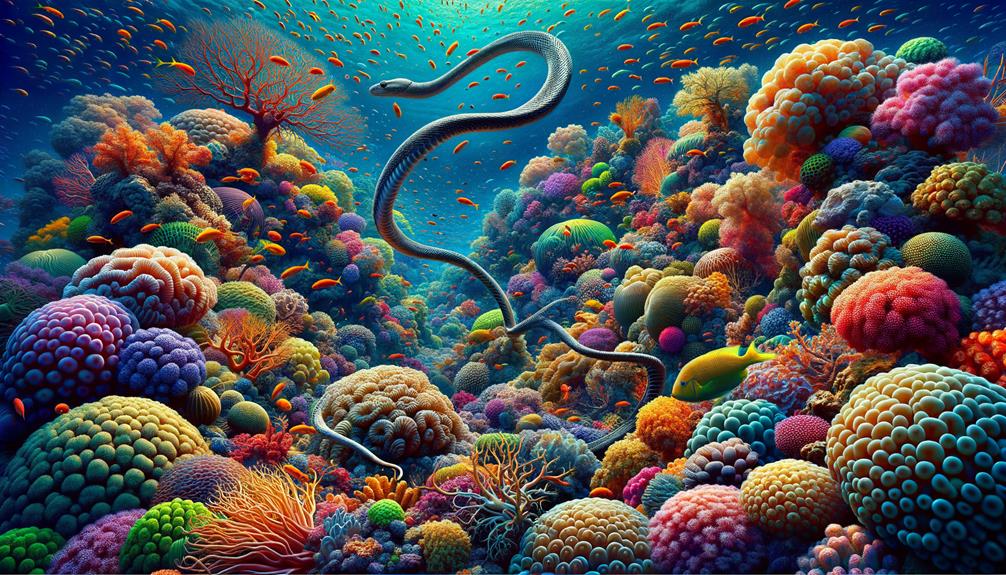While paddling through an Amazonian waterway, I spotted a Mata Mata turtle blending in with the surrounding leaf litter and debris. Its flat, jagged shell made it nearly invisible among the fallen foliage. This chance encounter sparked my interest in how these turtles have adapted to their specific environment.
Mata Matas have some fascinating features. Their tube-like snouts let them breathe while staying mostly underwater. When prey swims by, their powerful jaws snap shut with lightning speed.
Learning about these turtles' habits and habitats is becoming more important. As environmental pressures increase, efforts to protect these unique creatures are gaining urgency. Understanding how Mata Matas live and interact with their surroundings is key to developing effective conservation strategies.
Taxonomy
The story of mata mata turtle classification is a journey through scientific discovery spanning centuries. Pierre Barrère's 1741 description kicked things off, setting the stage for ongoing research. Fermín Zanón Cervera dubbed it Testudo terrestris in 1765, but that name didn't stick around. Johann Gottlob Schneider later tagged it as Testudo fimbriata in 1783. The big shift came in 1805 when André Marie Constant Duméril moved it to the Chelys genus, calling it Chelys fimbriata.
Recent genetic studies have shaken things up, revealing two distinct species where scientists once thought there was just one. This finding has expanded our knowledge of their evolution and where they live.
The Chelus fimbriatus classification isn't just a list of names – it's a window into growing scientific understanding. Each new discovery or reclassification adds another piece to the puzzle, giving us a clearer picture of these unusual turtles. This ongoing process shows how science keeps moving forward, always ready to update what we know based on new evidence.
Physical Characteristics
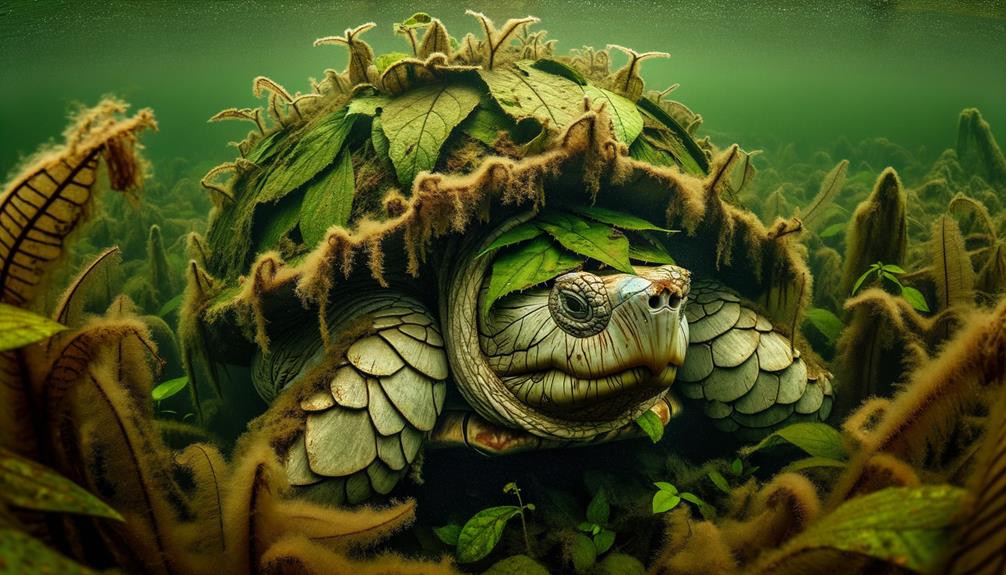
Let's take a closer look at what makes the mata mata turtle stand out. These creatures have some really cool features that help them thrive in the Amazon's murky waters.
Picture a turtle with a flat head and a bumpy neck – that's the mata mata. This odd look isn't just for show; it helps them blend in with leaves and debris at the bottom of rivers and streams. They've got a huge mouth too, which works like a mini-vacuum cleaner, sucking up fish and small animals in one quick gulp.
One of their most interesting bits is their long, tube-like snout. This clever adaptation lets them breathe while mostly underwater, so they don't have to come up for air as often. While their eyesight isn't great, they don't really need it. Instead, they rely on super-sensitive nerves and sharp hearing to get around and find food in their dark, muddy home.
Here's a quick rundown of their key features:
| Part of the Turtle | What It Looks Like | What It Does |
|---|---|---|
| Head | Flat and wide, with bumpy skin | Helps it hide |
| Mouth | Big and powerful | Catches prey easily |
| Snout | Long and tube-shaped | Lets it breathe underwater |
| Shell | Rough and often covered in algae | Camouflages it in the water |
These unique traits don't just make mata mata turtles look weird – they're perfectly adapted for life as underwater ambush predators. They're masters of disguise and expert hunters in their watery world.
Natural Habitat
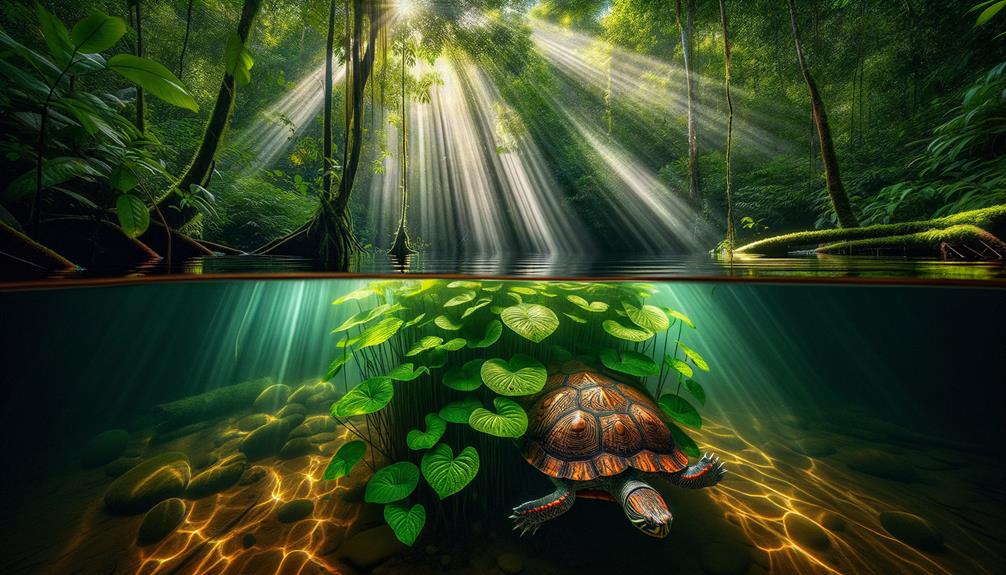
The Amazon Rainforest comes to mind when thinking about where Mata Mata turtles call home. These odd-looking reptiles prefer the mucky bottoms of slow-moving waterways, blending in seamlessly with the surrounding plants. They're right at home in swampy areas and along river edges, using these spots to hide from danger and surprise their next meal. The dense vegetation and murky waters provide the perfect backdrop for these masters of disguise to go about their daily lives, largely unnoticed by both predators and prey alike.
Amazon Rainforest Environment
The Amazon Rainforest houses mata mata turtles in its slow, muddy waterways. These creatures exemplify the adaptability found in this diverse ecosystem. Their unique appearance allows them to blend seamlessly with the murky riverbeds, making them nearly invisible to both hunters and potential meals.
Within the Amazon's rich tapestry of life, mata mata turtles have carved out a niche. They've perfected the art of ambush, lying in wait for unsuspecting prey. This predator-prey dynamic is typical of the Amazon, where each species contributes to the overall balance of the ecosystem.
The rainforest's abundance provides more than just food for these turtles; it offers crucial protection. Efforts to preserve the Amazon are vital not only for the mata mata but for countless other species that call this place home.
The complex web of life in the Amazon showcases nature's ingenuity. Here, creatures like the mata mata turtle have evolved remarkable strategies to thrive. By safeguarding this environment, we protect an irreplaceable natural wonder and the myriad life forms it sustains.
Water Bodies Preference
Mata mata turtles in the Amazon basin are right at home in slow-moving streams, swamps, and marshes. These spots are perfect for their sneaky ways – they blend in so well you'd never know they're there. They love muddy bottoms where they can disappear like magic, fooling both hunters and the fish they're after.
These turtles didn't just pick these places by chance. They're built for this kind of life. The murky, shallow waters of the Amazon are like a buffet for these crafty creatures. They lie still as can be, looking just like leaves or bits of wood, waiting for fish to swim by. It's a clever trick that only works in these special water spots.
What's neat is that mata matas can even handle a bit of salt. You'll find them in brackish waters down in the lower Amazon. It shows how tough they are, able to live in all sorts of watery homes. But here's the thing – they need these places to stay healthy. If we want to keep seeing these odd-looking turtles around, we've got to look after their homes too.
Shelter and Hiding Spots
In the murky depths of the Amazon, mata mata turtles are masters of disguise. Their bumpy shells, often coated in algae, blend perfectly with the muddy river bottom. These turtles are practically invisible, their knobby skin and flat heads mimicking floating debris.
Mata matas are the ultimate couch potatoes of the turtle world. They find a comfy spot among sunken logs or roots and just hang out. But don't let their laziness fool you – they're deadly ambush predators. When a fish swims too close, they strike faster than you can blink, gulping down their meal in one go.
This sit-and-wait strategy is key to their survival. The Amazon's underwater jungle provides countless hiding spots, perfect for their sneaky hunting style. By perfecting the art of camouflage, these turtles have found their niche in a world where eating and being eaten is the name of the game.
Behavior Patterns
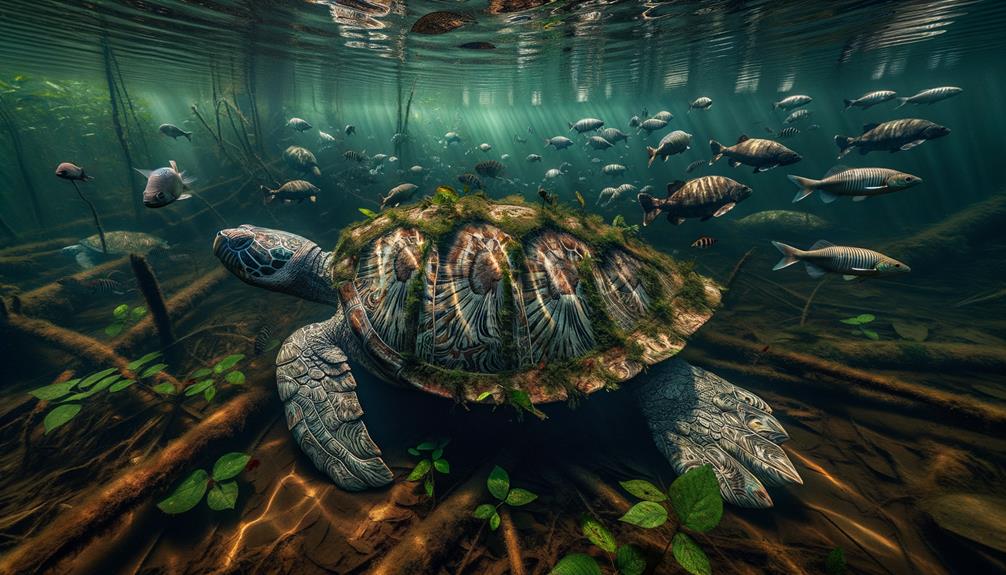
When you watch Mata Mata turtles, you'll quickly spot their night-time hunting habits. These clever reptiles have adapted perfectly to sneak around and surprise their prey in the Amazon's waters. They're most active when it's dark, using their amazing camouflage to blend right into the muddy rivers.
Their way of catching food is pretty cool. Instead of chasing after fish, these turtles create a strong suction with their big mouths. In a split second, they can slurp up fish and small water creatures that swim too close.
This laid-back approach to getting dinner helps the Mata Mata save energy while still catching plenty of food. They've fine-tuned their habits to fit in with the Amazon's daily rhythms, which keeps them safe from both hunters and the animals they want to eat. Their sneaky ambush method shows just how well they've adapted to a place where being stealthy is key.
Watching these turtles is quite an experience:
- You might jump when you see them strike suddenly and quickly.
- It's impressive how perfectly they blend into the river bottom.
- You can't help but admire how quietly and patiently they wait in dark spots.
Reproductive Process
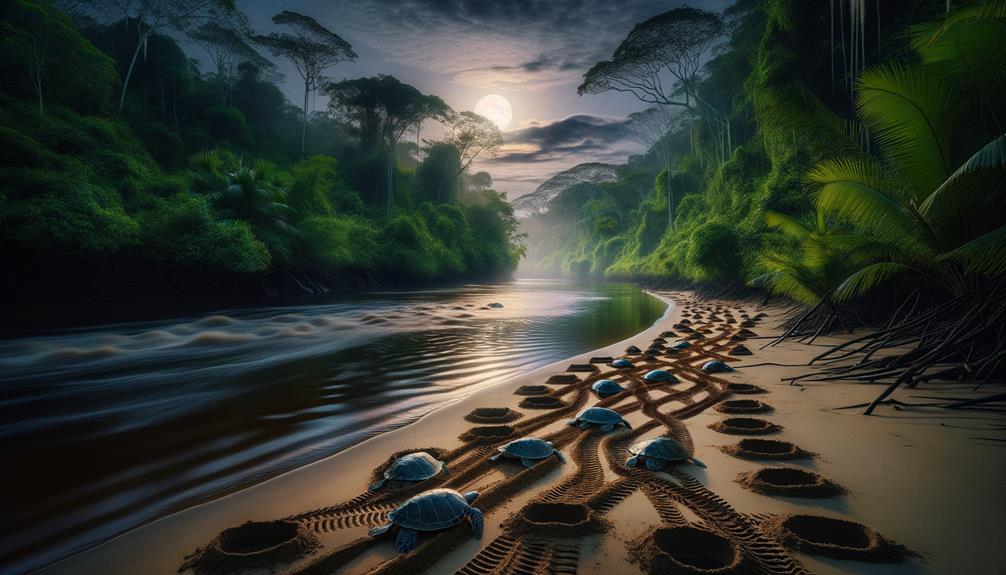
Mata Mata turtles have a unique way of making babies. From October to December, female turtles lay 12 to 28 eggs in shallow nests. They're picky about where they put these nests, often choosing spots near the edge of the forest. These moms-to-be don't just pick any old place; they check out the soil and make sure the area is stable. It's all about giving their kids the best shot at survival.
The male turtles have their own part to play. They try to woo the females with a special dance. They stick out their heads and move their side flaps in a particular way. It's quite a show, and it's crucial for getting the females interested before they go off to build their nests alone.
After the eggs are laid, they need about 200 days to hatch. The shallow nests protect the growing baby turtles, relying on the surrounding temperature and other natural factors to help them develop. This whole process shows how well Mata Mata turtles have adapted to life in the Amazon. It's a reminder of how tough these creatures are and how finely balanced their natural home is.
Dietary Habits
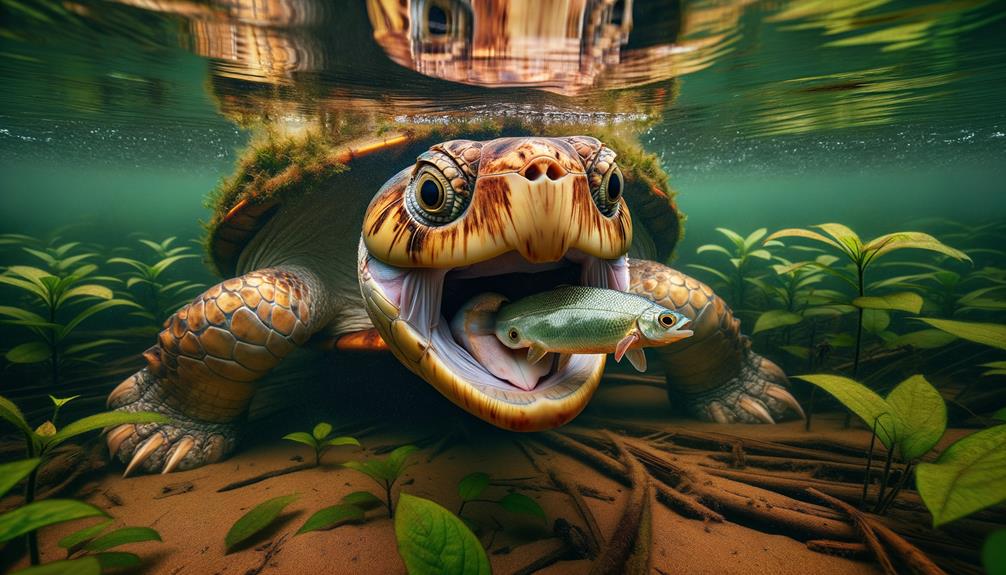
The eating habits of Mata Mata turtles in the Amazon are truly remarkable. These carnivorous reptiles primarily feast on fish, crustaceans, and other small aquatic creatures. What sets them apart is their unique feeding method – they create a powerful suction to capture their prey. Adding to their hunting prowess is a peculiar tongue that resembles a worm. This appendage acts as bait, enticing small fish to swim right into their waiting mouths. It's a clever adaptation that showcases the diverse strategies animals develop to thrive in their environments.
Carnivorous Feeding Patterns
The Mata Mata turtle's eating habits are truly remarkable. These Amazon dwellers have perfected a unique suction technique to catch their meals. When they spot potential food, they quickly open their wide mouths, creating a strong vacuum that pulls in water and any unlucky creatures nearby. Their special sensory nerves and side flaps help them detect even the tiniest movements in the water, making them expert hunters.
In the dark, muddy Amazon waters, these turtles are masters of disguise. They blend in perfectly with their surroundings, patiently waiting for the right moment to strike. As ambush hunters, they move slowly and carefully until it's time to act.
Watching a Mata Mata turtle feed is quite a sight. Their ability to pinpoint prey with such accuracy is impressive. The way they combine stealth and power in their hunting strategy is fascinating.
These turtles' hunting methods and sensory adaptations showcase the incredible ways animals survive in the wild. It's a testament to the power of instinct and the marvels of nature.
Preferred Prey Types
Mata Mata turtles have a unique way of hunting that's perfectly suited to their main food sources: fish, crustaceans, and other small water creatures found in the Amazon basin. These odd-looking turtles use a clever trick to catch their meals. They create a sort of underwater vacuum with their wide mouths, sucking in prey before it can escape. This method works especially well for nabbing quick little fish.
One of the turtle's most interesting features is a worm-like bit on its tongue. This acts as bait, luring unsuspecting prey close enough to be gulped down whole. Since Mata Matas don't have teeth, they've adapted to swallow their food in one go. This smart hunting style lets them thrive in slow-moving Amazon waters, where they can wait patiently for the right moment to strike.
Here's a quick look at what Mata Matas typically eat:
| Food Type | Details |
|---|---|
| Fish | Main part of their diet, caught quickly |
| Crustaceans | Includes small crabs and similar animals |
| Water Invertebrates | Various tiny creatures living in the Amazon |
These turtles are experts at surprise attacks, using their surroundings and special feeding tricks to catch food. Their eating habits show how well they've adapted to life in the Amazon's watery world.
Conservation Status
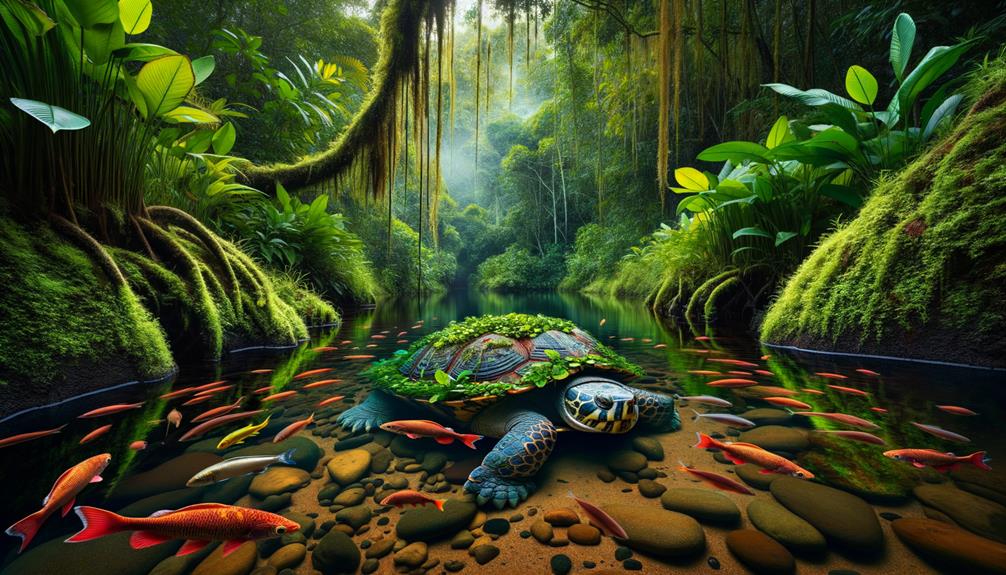
The Mata Mata turtle faces significant challenges, with its status now "Near Threatened" according to the IUCN. Habitat loss and illegal trading have hit populations hard, especially in the Amazon and Orinoco basins. Scientists are racing to understand and address these issues before it's too late.
While some countries have banned Mata Mata exports, underground markets persist. Public education is key to curbing demand and promoting habitat conservation. The situation is dire:
- Forests where these turtles live are shrinking due to human activity.
- Many are snatched from the wild for pet shops, often dying in transit.
- Their numbers are dropping, and without help, they could vanish.
Ongoing research is critical to protect these odd-looking creatures. Immediate action is needed to ensure Mata Matas don't slide further towards extinction.
Conservationists stress the need for stronger protections and public engagement. By raising awareness about the pet trade's impact and the importance of preserving natural habitats, we can make real progress. It's a race against time to save these remarkable turtles and maintain biodiversity in their ecosystems.
Unique Facts
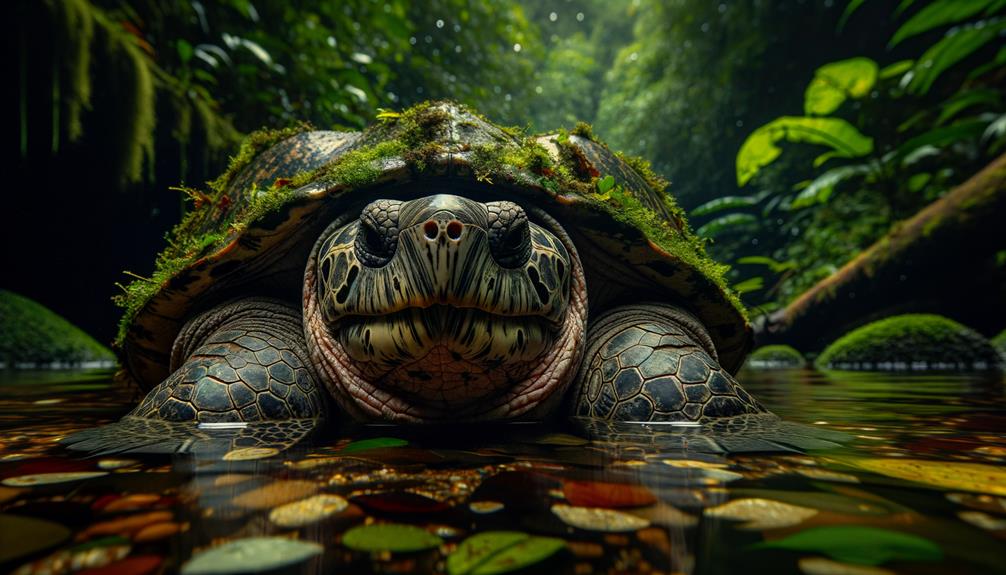
The Mata Mata turtle's odd looks play a key role in its survival. Living in the Amazon and Orinoco rivers, these turtles have a bumpy shell and wide, flat head that look just like tree bark and fallen leaves. This clever disguise helps them blend in perfectly, making them hard to spot for both hunters and food.
But there's more to the Mata Mata's strange appearance than just hiding. Their long, tube-like nose lets them breathe while staying still underwater, out of sight. When food swims by, the Mata Mata uses a special trick: it quickly opens its big mouth, creating a vacuum that sucks in water and any nearby small fish or water bugs.
Despite being so good at surviving, Mata Matas are now close to being at risk because people are destroying their homes and catching them for pets. These turtles in the Amazon and Orinoco rivers show how amazing nature can be, but also remind us that we need to act fast to protect these unique animals and where they live.
Frequently Asked Questions
Is Mata Mata Turtle Real or Not?
The Mata Mata turtle is indeed a real species. Its striking features include a distinctive snout and bumpy shell, making it a standout among aquatic creatures. This carnivore employs a unique feeding strategy, using suction to catch its prey. Efforts are ongoing to protect this intriguing species and its habitat.
Can You Have Mata Mata Turtles as Pets?
Mata Mata turtles can be fascinating pets for those intrigued by their unique looks and hunting style. However, keeping one requires careful consideration. You'll need to invest in a sizable aquarium, maintain warm water with low pH levels, and provide a steady supply of live prey. These turtles aren't your typical pet, but for enthusiasts willing to meet their specific needs, they can be a rewarding choice.
What Is the Lifespan of a Mata Mata?
Mata mata turtles boast impressive longevity, often reaching 75 years in captivity and potentially a century in their natural habitats. These remarkable reptiles typically reach sexual maturity around age 12, given proper care and suitable living conditions. Their long lifespan highlights the importance of providing appropriate environments and care for these unique creatures, whether in zoos, aquariums, or their wild ecosystems. Conservationists and turtle enthusiasts alike marvel at the mata mata's ability to thrive for decades, making them a subject of fascination and ongoing research in the field of herpetology.
How Do Mata Mata Turtles Protect Themselves?
Picture a living, breathing chunk of tree bark. I keep myself safe by melting into my environment, thanks to my rough, bumpy shell and a head decorated with flappy skin. When I don't move, I practically disappear, dodging predators like a pro.


